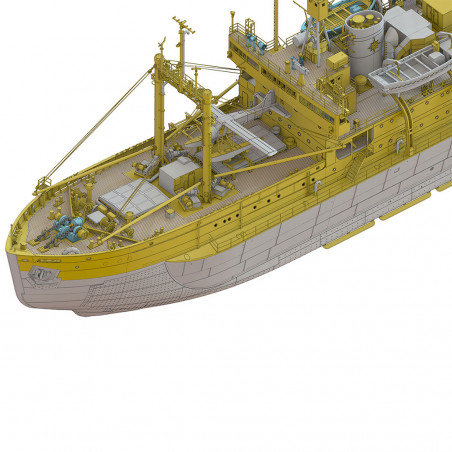



























To ride, fly, sail, everything is there at MHD!




























HASEGAWA introduces a stunning new plastic model kit of the Sōya at 1/250 scale, a remarkable creation following its earlier release of the same vessel at 1/350 scale several years ago.
This new edition features an entirely new mold, offering a wealth of details not present in the previous 1/350 version.

Plastic model ship ANTARTICA OBSERVATION SHIP SOYA "2nd expedition" 1:250
Plus de detailsPlastic model ship ANTARTICA OBSERVATION SHIP SOYA "2nd expedition" 1:250
ANTARTICA OBSERVATION SHIP SOYA "2nd expedition" 1:250
HASEGAWA introduces a stunning new plastic model of the Sōya at 1/250 scale, a remarkable creation following its earlier release of the same vessel at 1/350 scale several years ago.
This new edition features an entirely new mold, offering a wealth of details not present in the previous 1/350 version.
To enhance the already impressive realism of this model, HASEGAWA has collaborated with the Korean company PONTOS MODEL to provide an elaborate detailing set.
The box contains an impressive array of parts: 163 metal pieces, a wood-imitation deck, 25 resin pieces, 6 photo-etched plates, and decals.
At 1/250 scale, this boat plastic model kit from HASEGAWA boasts imposing dimensions of 665mm long by 330mm wide, allowing naval modeling enthusiasts to create a faithful and impressive replica of the Sōya.
It is worth noting that this model was produced in limited quantities and is unlikely to be reproduced in the future.
Model of a Japanese exploration ship to be assembled by gluing and painted.
History of the Sōya:
The Sōya, a Japanese icebreaker, holds a special place as a museum ship in Tokyo, bearing witness to a rich and eventful career that spanned some of the 20th century's most significant events. Its name pays homage to the Sōya Subprefecture located on the island of Hokkaido.
Originally, the ship was built under the name Volochaevets, commissioned by the Soviets in 1936 at the Matsuo shipyard on Koyagi Island in Nagasaki. This commission was part of a partial payment arrangement for Japan's construction of the South Manchuria Railway, also known as the Chinese Eastern Railway.
Designed as an ice-breaking cargo ship, the Volochaevets was completed as such for the Tatsunan Kisen Co. and was renamed Chiryō Maru. During this time, two other ice-strengthened cargo ships, the Bolshevik and the Komsomolets, were also ordered but were never delivered due to escalating tensions between Japan and the Soviet Union.
After World War II, as Japan found itself in a position of defeat and needing to repatriate millions of individuals from its former colonies, the Sōya was removed from the navy list and assigned duties with the nation's repatriation fleet. Significant modifications were made to the ship during this time, including the removal of its guns to make room for passenger facilities such as toilets in the large forward and aft cargo holds. Spacious wooden accommodations were also added on deck to accommodate passengers.
The Sōya undertook numerous repatriation missions, with stops in Shanghai, Tinian, and Guam, as well as voyages to and from Sakhalin, evacuating citizens under agreements with the new Soviet authorities.
During this period, it is important not to confuse the Sōya with the Soya Maru, one of three ice-strengthened passenger ferries that operated on the Japan National Railways maritime Chihaku Line between Odomari (current Korsakov) in Sakhalin and Wakkanai in Hokkaido.
In 1949, its repatriation duties ceased, and the Sōya was transferred to the Maritime Safety Agency, the precursor to the Japan Coast Guard. In this new role, it was tasked with supplying remote lighthouses along the Japanese coast, earning it the nickname "Santa Claus of the Sea" in some circles.
In 1950, the Sōya underwent a comprehensive overhaul in preparation for its service as Japan's first dedicated Antarctic research ship. This transformation included replacing its steam engine with twin diesel engines and installing a helicopter landing deck capable of storing light helicopters for exploration missions.
Over the following years, additional modifications were made, including the addition of a second helicopter deck above the first, creating a vast additional storage space.
Between 1956 and 1962, the Sōya undertook multiple missions to Antarctica, including the famous 1958 rescue of personnel stranded at the Showa research station, which made headlines worldwide.
This rescue mission is also famous for leaving behind 15 abandoned Karafuto-Ken huskies on the ice, two of which, named Taro and Jiro, managed to survive until the ship's return the following spring. Their story became iconic in Japan and was widely publicized worldwide, in part due to films such as "Nankyoku Monogatari" (Antarctica) and Disney's "Eight Below."
Despite its accomplishments, the Sōya also faced challenges during its Antarctic missions, including getting stuck in the ice and requiring assistance from the nearby Russian icebreaker Ob.
After retiring from Antarctic duties, the Sōya was reassigned as an ice-breaking rescue vessel for Japan's Maritime Safety Agency, with a base in Hokkaido.
In 1978, the Sōya was fully decommissioned, and its final mission was a farewell tour to the communities it had served, including the port of Hakodate. In 1979, the ship was moored alongside the Museum of Maritime Science in Tokyo, where it remains open to the public as a museum ship.
While its interior largely remains intact from its Antarctic exploration days, its superstructure has undergone significant modifications over the years, including the addition of a helicopter landing deck and higher forward gunwales, giving it a more imposing appearance than that of a simple cargo ship.
Customers who bought this product also bought:






